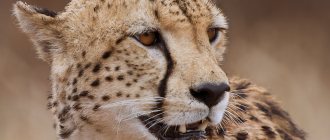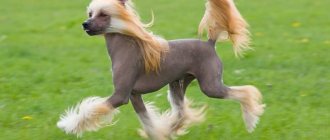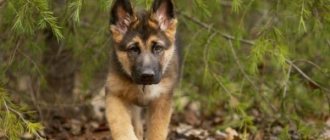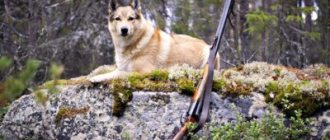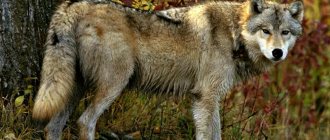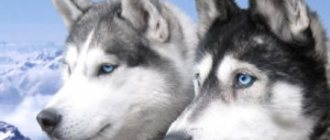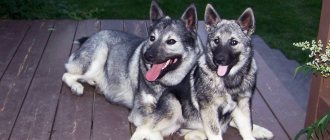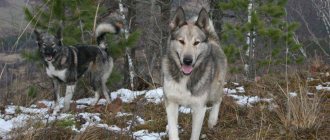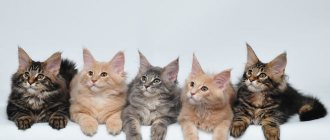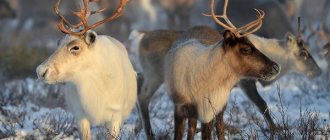Just the sight of an elk evokes a feeling of admiration in a person. A few centuries ago, moose were worshiped, so images of this animal are found in the sarcophagi of ancient burials, as well as in the dwellings of primitive people, such as caves. Moose have always represented strength and endurance. People simply call them “stalkers,” since the shape of the horns bears some resemblance to ancient agricultural tools.
The scientific name “elk” comes from the Old Church Slavonic language and meant “ols”. This concept was associated with the red color of the fur of moose calves. Siberians simply called the animal “beast”. The North American Indians were distrustful of this “beast,” so they retold the legend of the treacherous moose, but the Canadian Indians considered this “beast” a noble animal. In the city of Vyborg there is a monument to an elk, who at the cost of his life saved the lives of hunters who got lost.
Origin of the species and description
Drawing of the animal Cervalces, which is supposedly a relative of the moose.
It is still unknown what animal the moose came from. The oldest remains found by humans date back to the early periods of the Pliocene (approximately 5 million years ago). Also during this time period lived the beast Cervalces, which looked like an elk. They could well have descended from a common ancestor.
It has been established that in Neolithic times, approximately 9,500 years ago, moose, similar in appearance to modern ones, inhabited the territories of Ukraine, Transcaucasia, England and the lands of Western Europe.
Currently the animal lives in America, Asia and northern Europe. At the beginning of the last century, the number of moose decreased, but people began to preserve the population in time. The measures taken allowed the animal to once again expand its habitat.
Natural enemies
Recommended by topic
Muskrat Flying squirrel Chameleon
In their natural environment, moose do not have many enemies. Only bears, a pack of wolves, a lynx or a wolverine can cope with the mighty artiodactyl. But even in this case, the predator will have to show considerable intelligence. Moose flee for their lives, but if cornered by predators, they use their antlers and sharp front hooves.
A driven elk rests its croup against a natural shelter (tree, rock or bush) and puts its antlers forward. Predators in this situation try to avoid direct contact, since a blow from a hoof can break the skull of an adult bear. Therefore, predators leave dangerous prey and look for other food.
Mostly, old, sick or young animals become prey for predators. Sometimes bears attack pregnant females or drive an adult moose into deep snow or windfall. If a giant gets stuck in the snow or cannot turn around in front of the predator, then he has practically no chance of fighting off.
During the hunt, wolves try to fight off weak individuals from the herd. The pack then chases the animal until it runs out of strength. During the chase, predators bite the elk's hind legs, trying to tear the tendons or draw blood. The giant weakens, falls and becomes easy prey.
But the most dangerous predator at all times has been and remains man. The uncontrolled hunt for horned giants almost led to disaster. The extinction was stopped, but the population of artiodactyls is still under vigilant control, although it has left the risk zone.
Appearance and features
Close-up of a moose's hoof.
Moose are black and brown in color.
The coat is short, but there are noticeable extensions on the forehead and neck. The body is darker than the limbs. The latter have large narrow hooves with a point at the front. They are designed in such a way that when moving on grass and other soft surfaces, the body weight is distributed evenly. Interesting fact : the elk's head appears huge due to its nose, which is made of massive cartilage. It is oval in shape and blends smoothly into the upper lip.
Moose antlers close-up
The total length of both horns can reach 1.9 m, and the weight can be 45 kg. At the base they run in straight lines, but as they rise, numerous shoots appear. In the first year of life, individuals grow horns in thin stripes. Thanks to this, you can immediately determine its age. And only by five years, as they are renewed, their massiveness increases, and a large number of branches appear. Females do not have horns.
Adult moose grow up to 5.5 m in length, and their height sometimes reaches 2.5 m. The average weight of an individual is 650 kg. Males are larger than females. Despite its impressive dimensions, the animal is capable of moving quickly: its running speed can reach up to 40 km/h. Thanks to their strong hooves, moose confidently walk through dense forests, swamps and the foothills of mountains. They are excellent swimmers: if desired, the animal covers a distance of 3-5 km in water without much difficulty, and can also dive to great depths.
Age names
First of all, in order not to get confused in terms, you need to know what moose are called based on their age:
- Elk 1 year old - young of the year.
- About 1.5 - one and a half year old elk.
- 2 years or more – adult.
- After 10 years - old.
In addition, the hunters’ habit of calling a male elk a bull, a young elk a calf, and a female a cow will be interesting for a beginner. In terms of body structure, they are indeed somewhat similar, but the elk has a more elongated body, thin legs and antlers. Therefore, you should not be surprised if among the scientific literature there are references to bulls when talking about moose.
Why is it important to know how old a moose is? Because there are different hunting periods: according to the decree of the Russian Federation of January 10, 2009, hunting for sexually mature individuals is allowed from November 1 to December 31, in some areas - from October. In this case, individuals under 1 year of age should make up 20% of the entire population, which means that it is necessary to correctly determine whether the elk is a yearling or an adult. It is not so easy to confuse age groups; even by appearance you can determine which group a given animal belongs to.
Habitat - where moose live
Moose Habitat
Moose live in the Northern Hemisphere. Until the 19th century, its numerous populations were found in Europe, however, due to human activity, the animal almost completely disappeared from these lands. Only a century later, thanks to great efforts, it was possible to recreate conditions favorable for the spread of moose.
Interesting: Animals - species, list, names, description, where they live, photos and videos
At the moment, the animal lives in Russia, Belarus, Ukraine, Poland, the Czech Republic, Hungary and other European countries. In the Russian Federation it is found from the southern steppes all the way to the Kola Peninsula. In Asia, elk inhabited Northern Mongolia, the northeastern territories of China and the Far East. In North America, the animal lives in the northeastern states, Canada and Alaska.
Moose prefer to live in coniferous forests
The natural environment for moose is considered to be coniferous forests located in swampy areas, near which streams flow. They are also found in the tundra, near the banks of rivers, lakes and other fresh water bodies. If there are mountains near the habitat, then in most cases the animal settles on plateaus, near slopes and in valleys.
Moose prefer to lead a sedentary lifestyle and do not travel long distances unless necessary. If there is enough food in the surrounding area, the animal is more likely to spend its entire life there.
The animal prefers to live alone, but can form herds in places where there is a large amount of food.
Interesting fact : on the territory of the Russian Federation, places where moose come in large numbers for food are called “camps”, and in Canada they are called “yards”.
Animals in comparison with humans, and not only (35 photos).
We often see the largest animals on the Internet, which are twice, three times larger than people, and some are tens of times larger. But how big are they really? In order to understand the true size of many animals, it is not enough to carefully study their size. It is easier to do this if you compare large animals with humans, with other animals, or with themselves when they were small. And only then will their huge dimensions really impress you.
For example, let's take the blue whale, which is currently the largest living animal in the world. It weighs 150 tons and its length can reach 33 meters .
If this doesn't surprise you, then imagine that the size of this whale is comparable to two American school buses, each of which seats 40 people. An adult blue whale is longer than 18 adult males at 1.83 meters tall (if they lay down next to each other).
Now, you must admit, the size of the whale is much more impressive. Below we have put together a collection of animals for you, photographs taken in perspective will help you understand their size. So, sit back - we've got big animals covered, from large Maine Coons to giant Siberian tigers.
Source
What does it eat?
Moose eat plant foods.
The elk's diet consists exclusively of plant foods. It prefers leaves, shrubs, mushrooms, lichens and mosses. Depending on the time of year, the animal eats certain types of food.
In summer, the bulk of the diet consists of foliage, shrubs and plants growing near water bodies. A real delicacy is sedge. Among herbs, moose try to eat species that contain a large amount of moisture. In August, the animal, in addition to other food, eats mushrooms and berries. With the onset of autumn, it switches to tree branches and yellowed foliage, and in November it almost completely switches to bark.
In winter, moose eat raspberry bushes, as well as rowan, willow, fir and pine. If lichens are found on the territory, they are also eaten. If necessary, the animal is able to dig up snowdrifts and find food on the frozen ground.
Interesting fact : in winter, moose practically do not drink water, due to which they retain heat inside their bodies.
In the warm season, an adult eats 25-35 kg of food every day. In winter, the elk's appetite decreases significantly, and it requires only 11-14 kg. The animal's body needs a regular source of minerals, which is why they willingly drink salt water and lick rocks and soil.
Elk calves stay with their mother for up to one and a half years
After mating, males and females disperse until next year. Although they sometimes feed in the same areas, they tend to ignore each other.
In the spring, females give birth to one or two cubs, each weighing about 14 kg. Elk calves grow quickly and can exceed the size of a human by the age of five days. Young moose stay with their mothers until the next mating season because they cannot run fast and defend themselves from predators.
Photo: www.animalalliance.ca
Features of character and lifestyle
Moose bathes in water
In summer, moose try to stay in cool places. To escape the heat, they go neck-deep into water or lie on damp grass; in winter, they bury themselves in the snow, thus protecting themselves from frost.
Moose have poor eyesight, but perfect hearing. It is capable of detecting sounds at a distance of a kilometer. When it sees danger, the animal relies on its horns and its size, so it simply runs forward, hanging its head, regardless of where the enemy is.
Interesting: Polar bear
